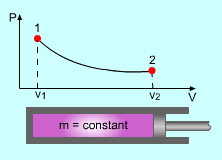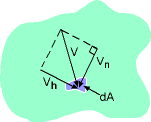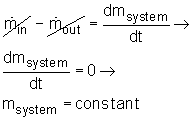| Ch 3. First Law of Thermodynamics | Multimedia Engineering Thermodynamics | ||||||
|
Conservation of Mass |
Conservation of Energy |
Solids and Liquids |
Ideal Gas | ||||
| Conservation of Mass | Case Intro | Theory | Case Solution |
| Chapter |
| 1. Basics |
| 2. Pure Substances |
| 3. First Law |
| 4. Energy Analysis |
| 5. Second Law |
| 6. Entropy |
| 7. Exergy Analysis |
| 8. Gas Power Cyc |
| 9. Brayton Cycle |
| 10. Rankine Cycle |
| Appendix |
| Basic Math |
| Units |
| Thermo Tables |
| eBooks |
| Dynamics |
| Fluids |
| Math |
| Mechanics |
| Statics |
| Thermodynamics |
| ©Kurt Gramoll |
| |
|||
| Mass and Volume Flow Rate |
|||
 Mass Flow Rate Through a Duct |
The mass flow rate ( d where |
||
|
|
Integrating the above equation to get the total mass flow rate. The volume flow rate ( The mass and volume flow rate are related by |
||
| Conservation of Mass Principle |
|||
|
|
The conservation of mass principle states the following:
In an equation format, the conservation of mass principle is: (Total mass entering the system) |
||
 Filling and Emptying Bathtub is an Example of Mass Conservation |
or, min - mout = Δmsystem where The rate form of the conservation of mass principle is: (Rate at which mass entering the system) or, |
||
| Conservation of Mass for Closed System |
|||

Mass Remains Constant for a |
A closed system is defined as a system which mass can not cross its boundaries, but energy transfer is allowed. Since no mass flows in or out of the system, the mass of the closed system remains constant during a process. |
||


